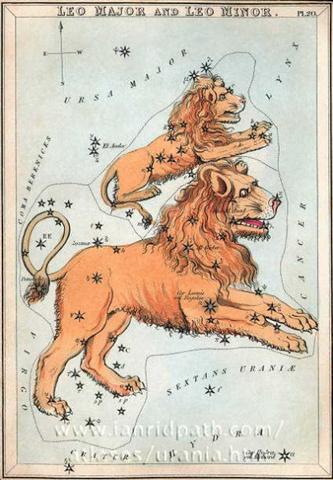9. Allen: "Bartschius drew on his map of this part of the sky the River Jordan, his Jordanis and Jordanus, not now recognized, indeed hardly remembered. Its course was from Cor Caroli, under the Bears and above Leo, Cancer, and Gemini, through the stars from which Hevelius afterwards formed Leo Minor and the Lynx, ending at Camelopardalis. But the outlines of his stream were left somewhat undetermined, much like those of Central African waters when guessed at by map-makers thirty years or more ago. This river, however, had already existed before his day on French star-maps and -globes." I have not discussed Leo Minor and the other 'minor' constellations, but pairs of constellations could be similar in meaning to pairs of glyphs.   (Picture from Andreas Cellarius' Harmonia macrocosmica according to Linda Hall's site.)Let's end with a picture of the Cor Caroli constellation (from Edward Sherburne's The Sphere of Marcus Manilius, 1675, according to Lina Hall):  Cor means heart - like in Cor Leone (the Heart of the Lion = Regulus). We should remember 'the heart of many circuits': ... In the inscriptions of Dendera, published by Dümichen, the goddess Hathor is called 'lady of every joy'. For once, Dümichen adds: Literally ... 'the lady of every heart circuit'. This is not to say that the Egyptians had discovered the circulation of the blood. But the determinative sign for 'heart' often figures as the plumb bob at the end of a plumb line coming from a well-known astronomical or surveying device, the merkhet. Evidently, 'heart' is something very specific, as it were the 'center of gravity' ... See Aeg.Wb. 2, pp. 55f. for sign of the heart (ib) as expressing generally 'the middle, the center'. And this may lead in quite another direction. The Arabs preserved a name for Canopus - besides calling the star Kalb at-tai-man ('heart of the south') ... Suhail el-wezn, 'Canopus Ponderosus', the heavy-weighing Canopus, a name promptly declared meaningless by the experts, but which could well have belonged to an archaic system in which Canopus was the weight at the end of the plumb line, as befitted its important position as a heavy star at the South Pole of the 'waters below'. Here is a chain of inferences which might or might not be valid, but it is allowable to test it, and no inference at all would come from the 'lady of every joy'. The line seems to state that Hathor (= Hat Hor, 'House of Horus') 'rules' the revolution of a specific celestial body - whether or not Canopus is alluded to - or, if we can trust the translation 'every', the revolution of all celestial bodies. As concerns the identity of the ruling lady, the greater possibility speaks for Sirius, but Venus cannot be excluded; in Mexico, too, Venus is called 'heart of the earth'. The reader is invited to imagine for himself what many thousands of such pseudo-primitive or poetic interpretations must lead to: a disfigured interpretation of Egyptian intellectual life ... Sir Scarborough, whose idea it was to put a Heart here, was not only a court physician, he was also a mathematician: "Sir Charles Scarborough ... (19 December 1615 – 26 February 1693) was an English physician and mathematician ... While at Oxford he was a student of William Harvey [who 'discovered' the circulation of the blood], and the two would become close friends ..." (Wikipedia) |